Experimental Study on Microbial-Induced Calcium Carbonate Precipitation Repairing Fractured Rock under Different Temperatures
Abstract
1. Introduction
2. Materials and Methods
2.1. Bacteria Selection and Rock Sample Preparation
2.2. Experimental Schemes
3. Results and Analysis
3.1. Repairing Effect of MICP on the Surface
3.2. Repairing Effect of MICP on Permeability and Porosity
3.3. Effect of MICP on UCS of Fractured Rock Samples
4. Discussion
4.1. Influence of Temperature on Biological Activity
4.2. Microscopic Analysis of MICP Products
4.3. Influence of Temperature on the Composition and Morphology of Cement
5. Conclusions
- The optimum temperature for Sporosarcina pasteurii to repair the fractured yellow sandstone is about 33 °C. The repair effect between 33 °C and 39 °C is better than between 27 °C and 30 °C.
- The MICP can effectively improve impermeability and strength. At the optimum temperature, the permeability and porosity of repaired fractured yellow sandstone are reduced by 98.761% and 55.174%, respectively. The average uniaxial compressive strength is restored to 6.24 MPa.
- The main form of CaCO3 crystals produced in the process of MICP is calcite. At 33 °C, the deposition of CaCO3 minerals is the highest. The CaCO3 crystals fill in the pore of rock, reducing the size and number of large pores and decreasing the permeability and strength of fractured yellow sandstone.
Author Contributions
Funding
Institutional Review Board Statement
Informed Consent Statement
Data Availability Statement
Conflicts of Interest
References
- DeJong, J.T.; Mortensenb, B.M.; Martinez, B.C.; Nelson, D.C. Bio-mediated soil improvement. Ecol. Eng. 2010, 36, 197–210. [Google Scholar] [CrossRef]
- Karol, R.H. Chemical Grouting and Soil Stabilization; Marcel Dekker: New York, NY, USA, 2003. [Google Scholar]
- Boquet, E.; Boronat, A.; Ramos-Cormenzana, A. Production of calcite (calcium carbonate) crystals by bacteria is a common phenomenon. Nature 1973, 45, 527. [Google Scholar] [CrossRef]
- Seifan, M.; Samani, A.K.; Berenjian, A. A novel approach to accelerate bacterially induced calcium carbonate precipitation using oxygen releasing compounds (ORCs). Biocatal. Agric. Biotechnol. 2017, 12, 299–307. [Google Scholar] [CrossRef]
- Lowenstam, H.A.; Margulis, L. Evolutionary prerequisites for early phanerozoic calcareous skeletons. Biosystems 1980, 12, 27–41. [Google Scholar] [CrossRef]
- Lowenstam, H.A. Minerals formed by organisms. Science 1981, 211, 1126–1131. [Google Scholar] [CrossRef]
- Shrestha, P.; Gautam, R.; Ashwath, N. Effects of agronomic treatments on functional diversity of soil microbial community and microbial activity in a revegetated coal mine spoil. Geoderma 2019, 338, 40–47. [Google Scholar] [CrossRef]
- Zhou, J.; Chen, D.; Huang, R.; Huang, G.; Yuan, Y.; Fan, H. Effects of bacterial-feeding nematodes on soil microbial activity and the microbial community in oil-contaminated soil. J. Environ. Manag. 2019, 234, 424–430. [Google Scholar] [CrossRef]
- Van Passen, L.A.; Daza, C.M.; Staal, M.; Sorokin, D.Y.; van der Zon, W.; van Loosdrecht, M.C.M. Potential soil reinforcement by biological denitrification. Ecol. Eng. 2010, 36, 168–175. [Google Scholar] [CrossRef]
- Qian, C.X.; Ren, L.F.; Luo, M. Development of Concrete Surface Defects and Cracks Repair Technology Based on Microbial-Induced Mineralization. J. Chin. Ceram. Soc. 2015, 43, 619–631. [Google Scholar] [CrossRef]
- Dejong, J.T.; Soga, K.; Banwart, S.A.; Whalley, W.R.; Ginn, T.R.; Nelson, D.C.; Mortensen, B.M.; Martinez, B.C.; Barkouki, T. Soil engineering in vivo: Harnessing natural biogeochemical systems for sustainable, multi-functional engineering solutions. J. R. Soc. Interface 2011, 8, 1–15. [Google Scholar] [CrossRef]
- Minto, J.; MacLachlan, E.; El Mountassir, G.; Lunn, R.J. Rock fracture grouting with microbially induced carbonate precipitation. Water Resour. Res. 2016, 52, 8827–8844. [Google Scholar] [CrossRef]
- Cuthbert, M.O.; Mcmillan, L.A.; Handley-Sidhu, S.; Riley, M.S.; Tobler, D.J.; Phoenix, V.R. A field and modeling study of fractured rock permeability reduction using microbially induced calcite precipitation. Environ. Sci. Technol. 2013, 47, 13637–13643. [Google Scholar] [CrossRef] [PubMed]
- Phillips, A.J.; Cunningham, A.B.; Gerlach, R.; Hiebert, R.; Hwang, C.; Lomans, B.P. Fracture Sealing with Microbially-induced Calcium Carbonate Precipitation: A Field Study. Environ. Sci. Technol. 2016, 50, 4111–4117. [Google Scholar] [CrossRef] [PubMed]
- Deng, H.W.; Luo, Y.L.; Deng, J.R.; Wu, L.J.; Zhang, Y.N.; Peng, S.Q. Experimental study of improving impermeability and strength of fractured rock by microbial induced carbonate precipitation. Rock Soil Mech. 2019, 40, 3542–3548. [Google Scholar] [CrossRef]
- Gao, R.; Luo, Y.; Deng, H. Experimental study on repair of fractured rock mass by microbial induction technology. R. Soc. Open Sci. 2019, 6, 191318. [Google Scholar] [CrossRef]
- Liu, D.; Shao, A.L.; Jin, C.Y.; Yan, L. Healing technique for rock cracks based on Microbiologically Induced Calcium Carbonate mineralization. J. Mater. Civ. Eng. 2018, 30, 82–86. [Google Scholar] [CrossRef]
- Liang, C.; Shahin, M.A.; Mujah, D. Influence of Key Environmental Conditions on Microbially Induced Cementation for Soil Stabilization. J. Geotech. Geoenviron. Eng. 2017, 143, 04016083. [Google Scholar] [CrossRef]
- Sun, X.H.; Miao, L.C.; Tong, T.Z.; Wang, C.C. Study of the effect of temperature on microbially induced carbonate precipitation. Acta Geotech. 2018, 14, 627–638. [Google Scholar] [CrossRef]
- Omoregie, A.I.; Khoshdelnezamiha, G.; Senian, N.; Ong, D.E.L.; Nissom, P.M. Experimental optimisation of various cultural conditions on urease activity for isolated Sporosarcina pasteurii strains and evaluation of their biocement potentials. Ecol. Eng. 2017, 109, 65–75. [Google Scholar] [CrossRef]
- SL264-2001. Specifications for Rock Tests in Water Conservancy and Hydroelectric Engineering. China Water & Power Press: Beijing, China, 2001.
- Coates, G.R.; Peveraro, R.C.A.; Hardwick, A.; Roberts, D. The Magnetic Resonance Imaging Log Characterized by Comparison with Petrophysical Properties and Laboratory Core Data. In Proceedings of the SPE Annual Technical Conference and Exhibition, Dallas, TX, USA, 6–9 October 1991. [Google Scholar] [CrossRef]
- Huang, Y.H.; Yang, S.Q.; Ranjith, P.G.; Zhao, J. Strength failure behavior and crack evolution mechanism of granite containing pre-existing non-coplanar holes: Experimental study and particle flow modeling. Comput. Geotech. 2017, 88, 182–198. [Google Scholar] [CrossRef]
- Wang, J.Y.; Snoeck, D.; Van Vlierberghe, S.; Verstraete, W.; Belie, N.D. Application of hydrogel encapsulated carbonate precipitating bacteria for approaching a realistic self-healing in concrete. Constr. Build. Mater. 2014, 68, 110–119. [Google Scholar] [CrossRef]
- Jonkers, H.M.; Thijssen, A.; Muyzer, G.; Copuroglu, O.; Schlangen, E. Application of bacteria as self-healing agent for the development of sustainable concrete. Ecol. Eng. 2010, 36, 230–235. [Google Scholar] [CrossRef]
- Moyo, C.C.; Kissel, D.E.; Cabrera, M.L. Temperature effects in soil urease activity. Soil Biol. Biochem. 1989, 21, 935–938. [Google Scholar] [CrossRef]
- Guan, S.Y. Soil Enzymes and Their Research Methods; China Agricultural Publishing House: Beijing, China, 1987. [Google Scholar]
- Deng, H.W.; Liu, C.J.; Ke, B.; Wang, Y.; Zhang, Y.N. Experimental study on microscopic damage characteristics of granite under cyclic dynamic disturbances. Chin. J. Eng. 2017, 39, 1634–1639. [Google Scholar] [CrossRef]
- Lin, Y.; Zhou, K.P.; Gao, R.G.; Li, J.L.; Zhang, J. Influence of Chemical Corrosion on Pore Structure and Mechanical Properties of Sandstone. Geofluids 2019, 2019, 7320536. [Google Scholar] [CrossRef]
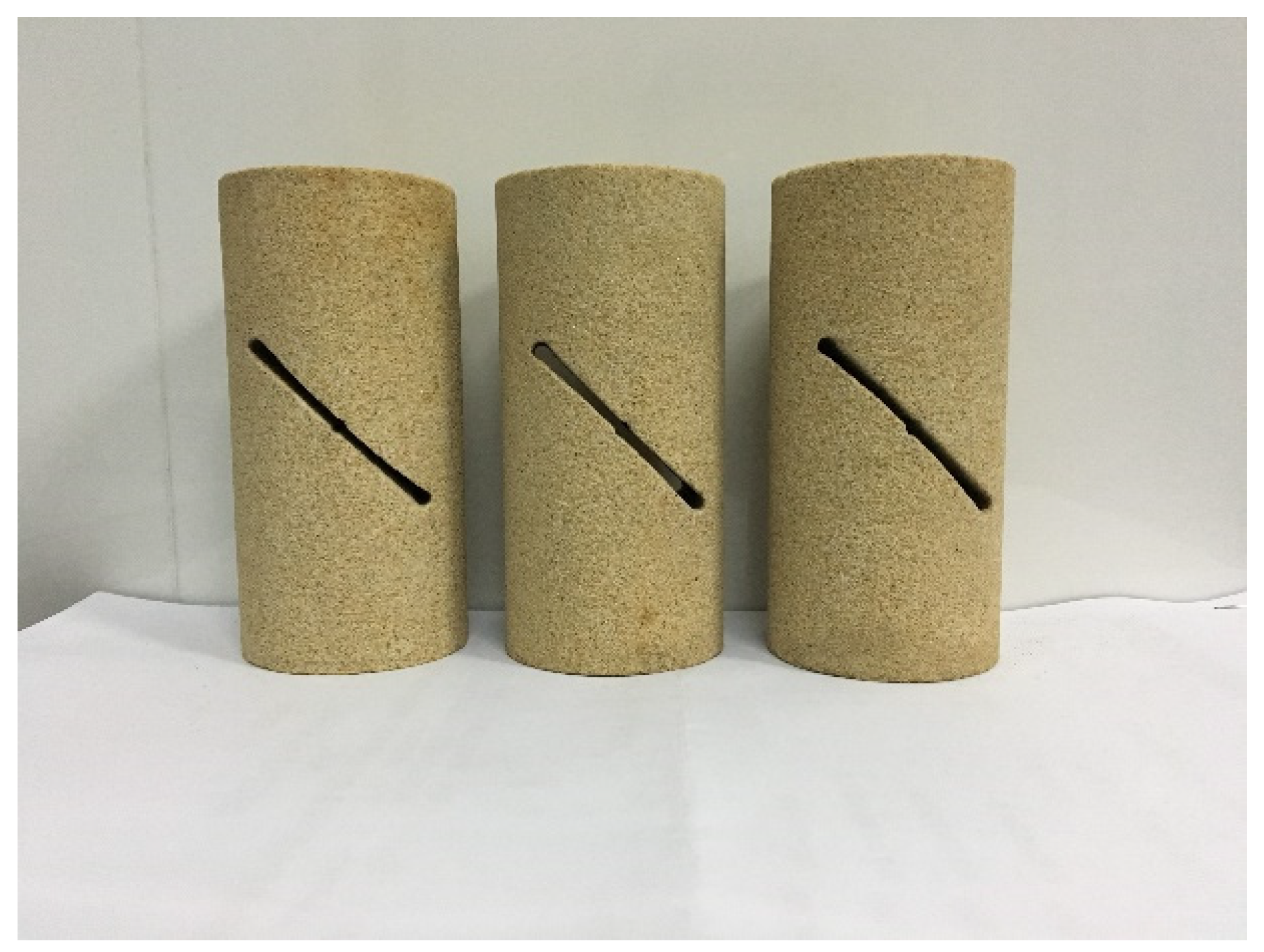
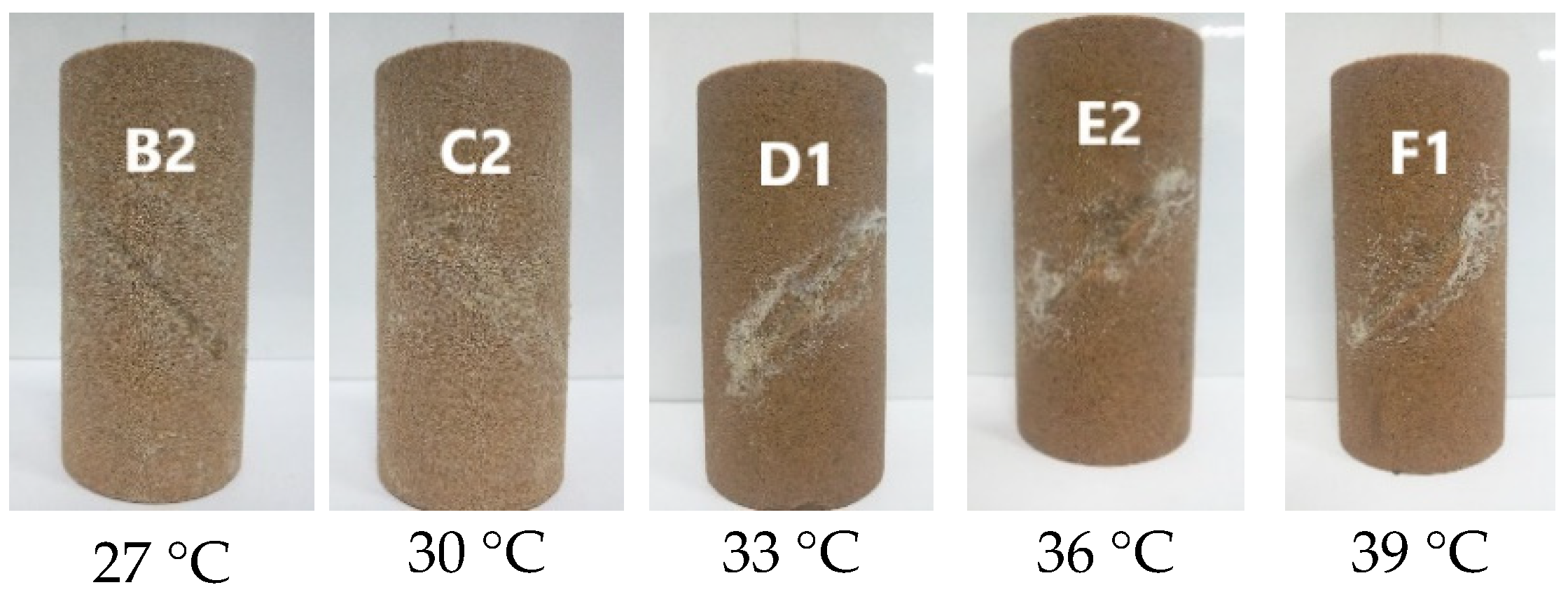
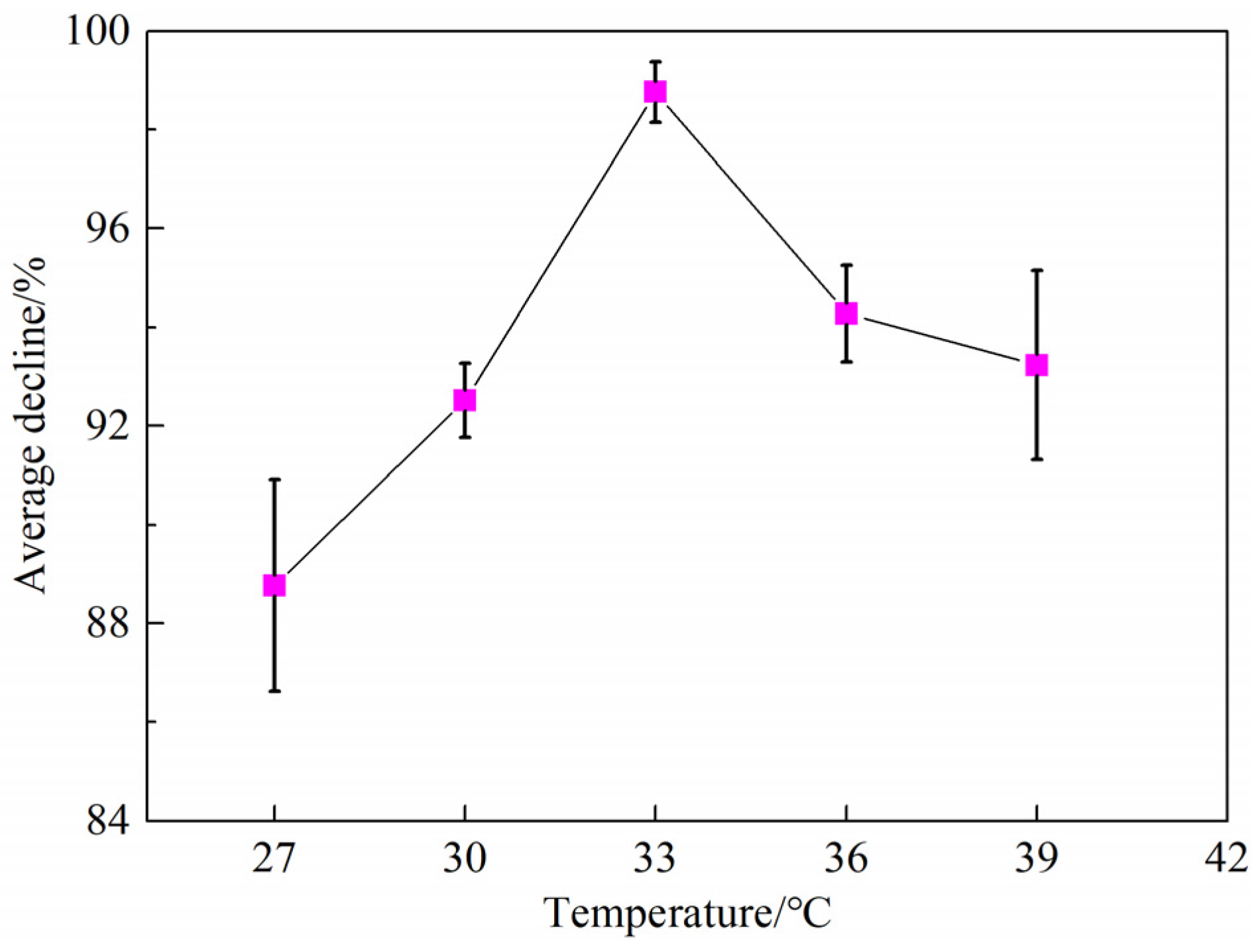
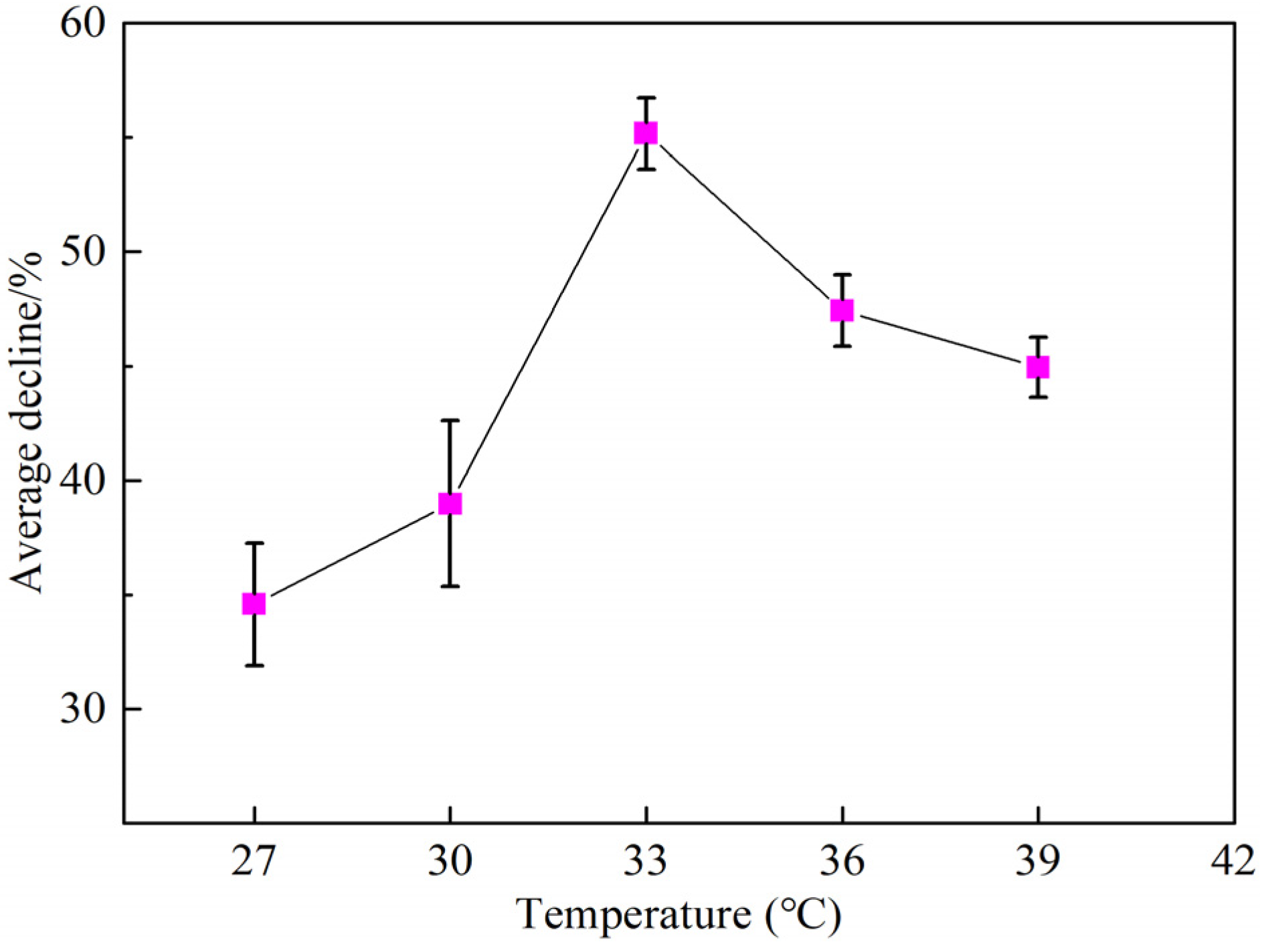
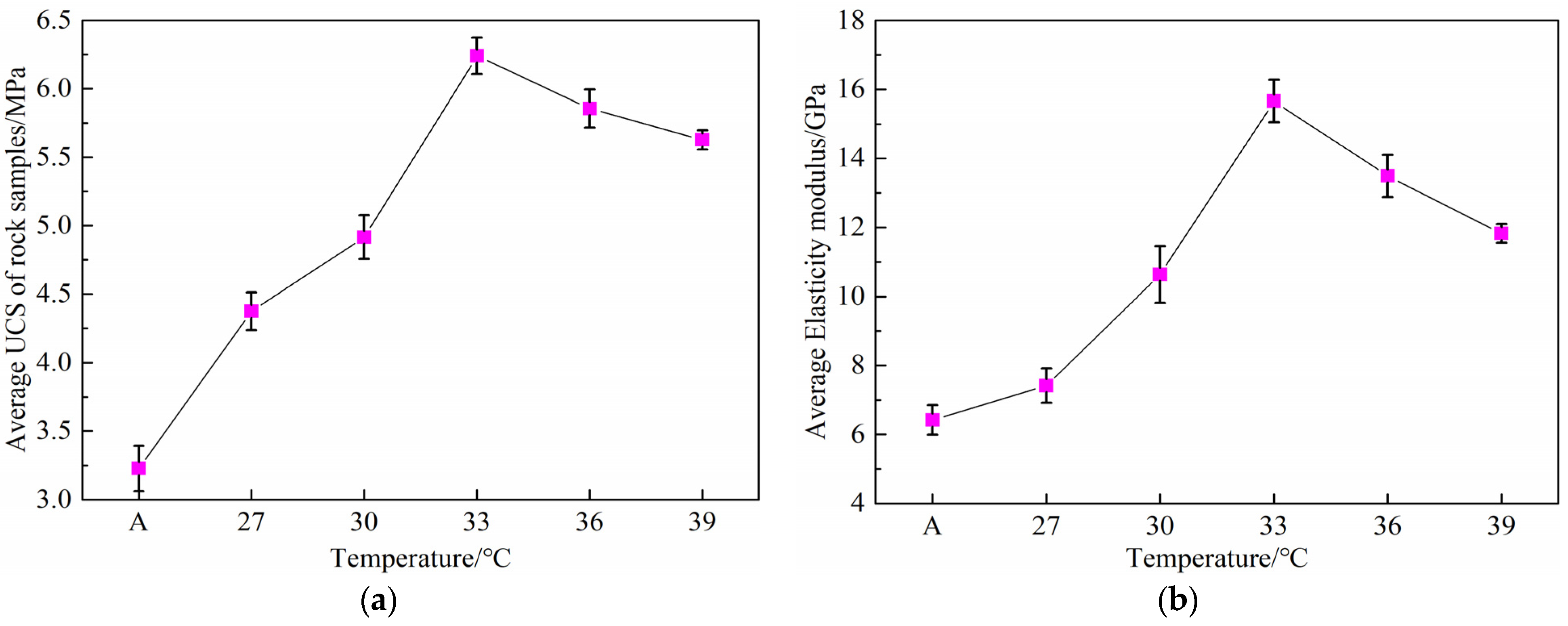
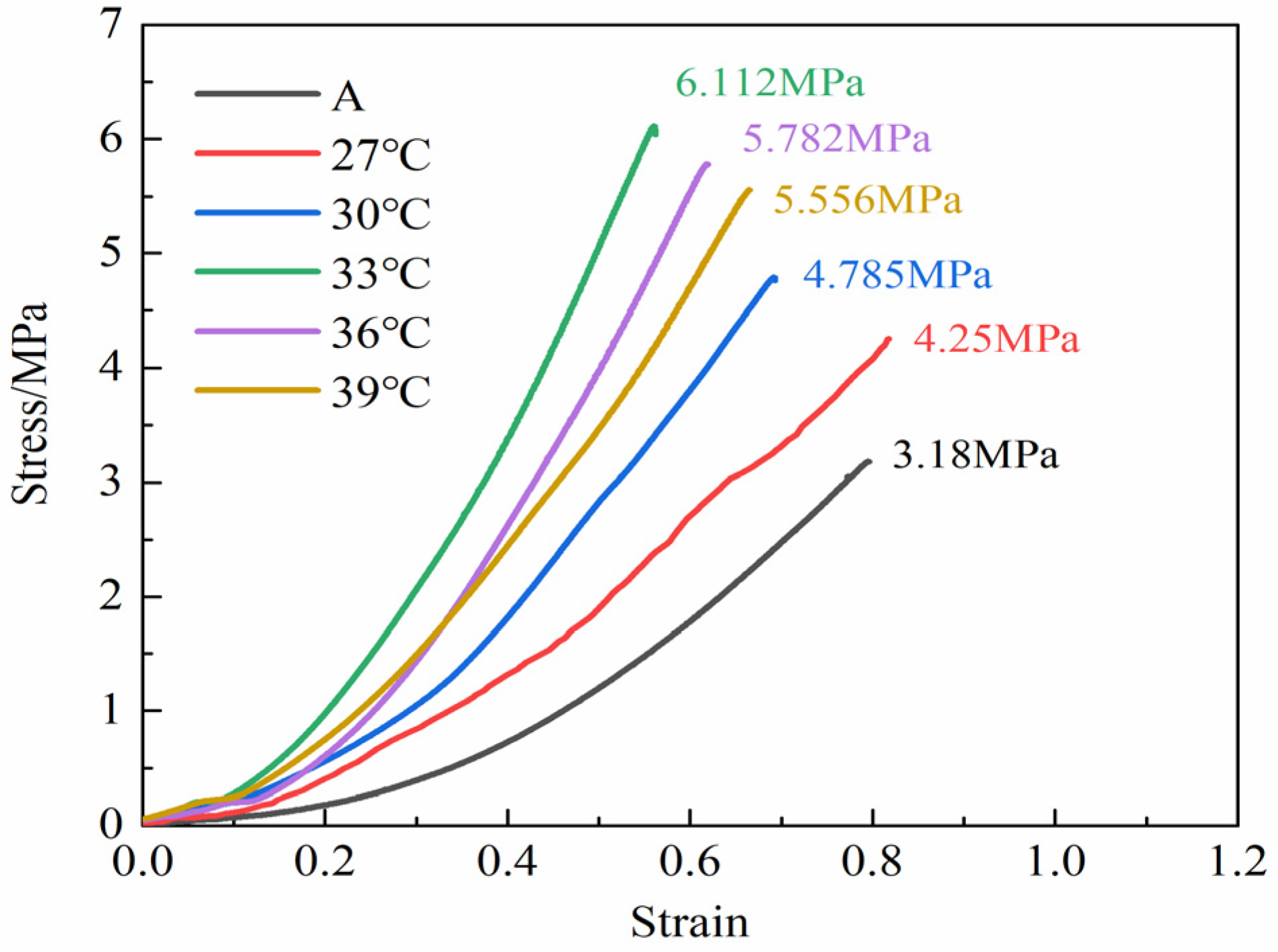
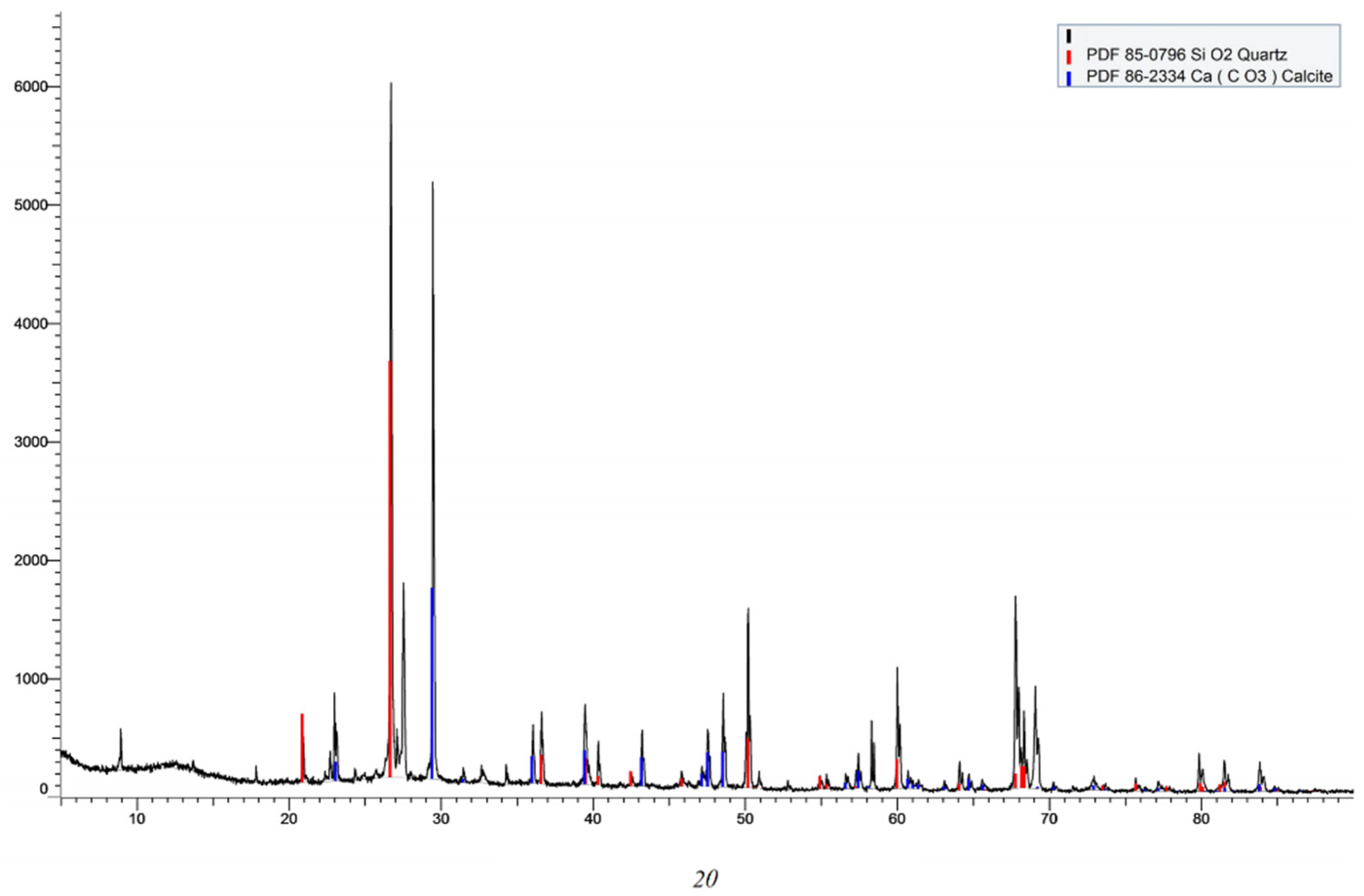
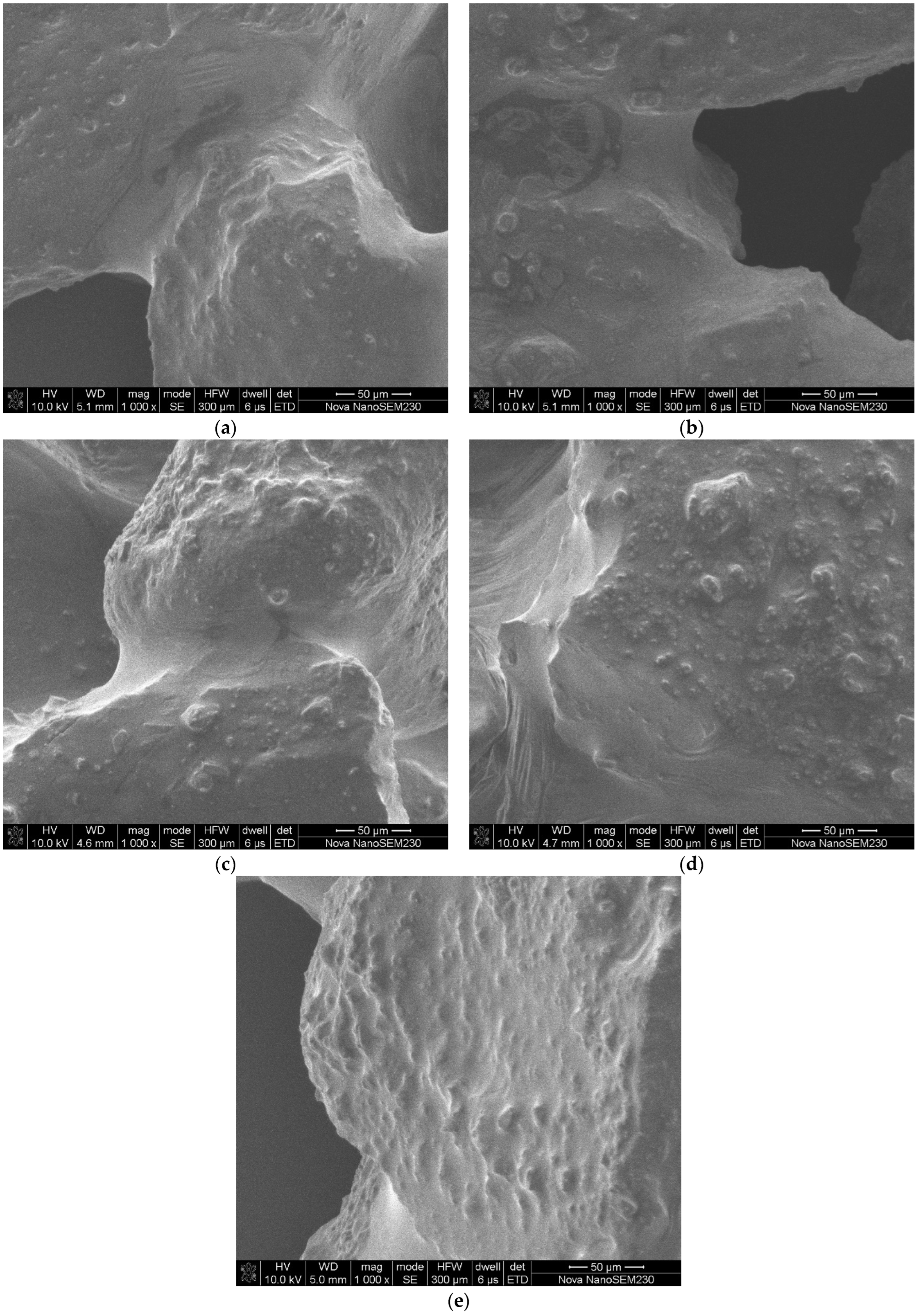
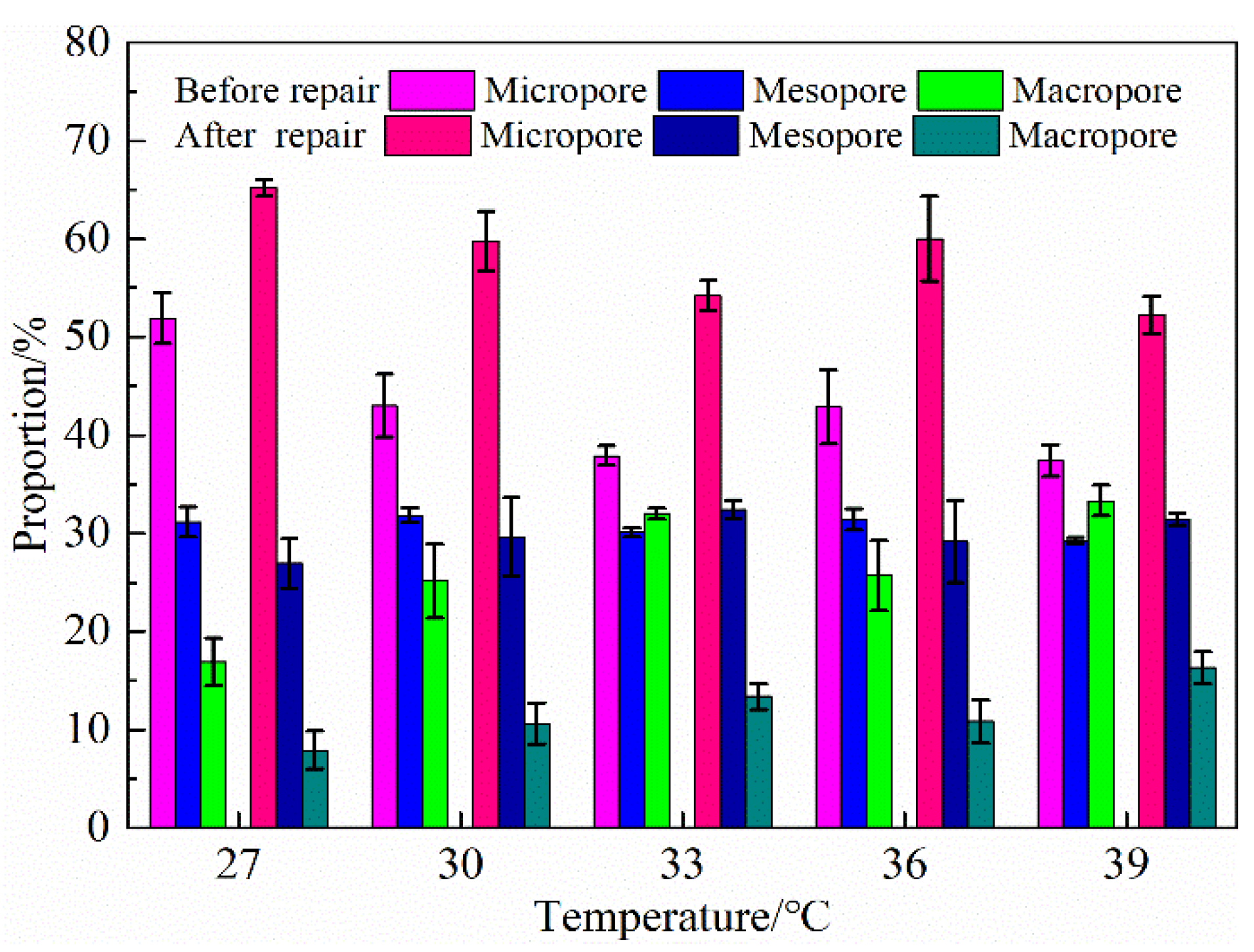
| Group and Number | Temperature (°C) | Height (mm) | Wave Speed (×103 m/s) |
|---|---|---|---|
| A1 | - | 99.48 | 1.17 |
| A2 | 99.56 | 1.13 | |
| A3 | 99.92 | 1.16 | |
| B1 | 27 °C | 99.10 | 1.15 |
| B2 | 99.50 | 1.14 | |
| B3 | 99.24 | 1.16 | |
| C1 | 30 °C | 100.12 | 1.17 |
| C2 | 99.26 | 1.16 | |
| C3 | 99.24 | 1.14 | |
| D1 | 33 °C | 99.44 | 1.15 |
| D2 | 99.18 | 1.17 | |
| D3 | 99.14 | 1.14 | |
| E1 | 36 °C | 99.20 | 1.15 |
| E2 | 99.20 | 1.14 | |
| E3 | 99.00 | 1.16 | |
| F1 | 39 °C | 99.22 | 1.15 |
| F2 | 98.66 | 1.16 | |
| F3 | 99.94 | 1.14 |
| Number | Temperature (°C) | Pre-Repair Permeability (mD) | Post-Repair Permeability (mD) | Average Decline (%) |
|---|---|---|---|---|
| A1 | - | 111.579 | ||
| A2 | 102.797 | |||
| A3 | 115.589 | |||
| B1 | 27 °C | 109.655 | 14.135 | 88.768 |
| B2 | 117.008 | 9.968 | ||
| B3 | 92.107 | 11.317 | ||
| C1 | 30 °C | 101.053 | 7.29 | 92.517 |
| C2 | 81.089 | 6.757 | ||
| C3 | 90.896 | 6.274 | ||
| D1 | 33 °C | 116.833 | 2.051 | 98.761 |
| D2 | 113.074 | 0.635 | ||
| D3 | 114.834 | 1.609 | ||
| E1 | 36 °C | 111.3 | 5.298 | 94.274 |
| E2 | 101.607 | 5.807 | ||
| E3 | 92.579 | 6.206 | ||
| F1 | 39 °C | 94.823 | 5.136 | 93.233 |
| F2 | 109.511 | 6.352 | ||
| F3 | 95.22 | 8.649 |
| Number | Temperature (°C) | Pre-Repair Porosity (%) | Post-Repair Porosity (%) | Average Decline (%) |
|---|---|---|---|---|
| A1 | - | 16.482 | ||
| A2 | 16.571 | |||
| A3 | 17.129 | |||
| B1 | 27 °C | 15.538 | 10.631 | 34.582 |
| B2 | 16.131 | 10.213 | ||
| B3 | 15.787 | 10.186 | ||
| C1 | 30 °C | 15.671 | 9.433 | 38.978 |
| C2 | 15.320 | 9.956 | ||
| C3 | 16.118 | 9.330 | ||
| D1 | 33 °C | 16.570 | 7.516 | 55.174 |
| D2 | 16.508 | 7.109 | ||
| D3 | 16.472 | 7.586 | ||
| E1 | 36 °C | 16.555 | 8.918 | 47.425 |
| E2 | 16.401 | 8.695 | ||
| E3 | 15.657 | 7.960 | ||
| F1 | 39 °C | 16.208 | 9.086 | 44.954 |
| F2 | 16.829 | 9.013 | ||
| F3 | 16.460 | 9.139 |
| Number | Temperature (°C) | UCS (MPa) | Elasticity Modulus (GPa) |
|---|---|---|---|
| A1 | - | 3.18 | 6.907 |
| A2 | 3.09 | 6.096 | |
| A3 | 3.41 | 6.267 | |
| B1 | 27 °C | 4.354 | 6.922 |
| B2 | 4.25 | 7.403 | |
| B3 | 4.522 | 7.919 | |
| C1 | 30 °C | 4.869 | 9.913 |
| C2 | 5.095 | 11.524 | |
| C3 | 4.785 | 10.477 | |
| D1 | 33 °C | 6.229 | 15.943 |
| D2 | 6.379 | 15.896 | |
| D3 | 6.112 | 14.855 | |
| E1 | 36 °C | 5.769 | 13.695 |
| E2 | 5.782 | 12.807 | |
| E3 | 6.016 | 13.979 | |
| F1 | 39 °C | 5.697 | 11.558 |
| F2 | 5.629 | 12.100 | |
| F3 | 5.556 | 11.817 |
Publisher’s Note: MDPI stays neutral with regard to jurisdictional claims in published maps and institutional affiliations. |
© 2022 by the authors. Licensee MDPI, Basel, Switzerland. This article is an open access article distributed under the terms and conditions of the Creative Commons Attribution (CC BY) license (https://creativecommons.org/licenses/by/4.0/).
Share and Cite
Deng, J.; Deng, H.; Zhang, Y.; Luo, Y. Experimental Study on Microbial-Induced Calcium Carbonate Precipitation Repairing Fractured Rock under Different Temperatures. Sustainability 2022, 14, 11770. https://doi.org/10.3390/su141811770
Deng J, Deng H, Zhang Y, Luo Y. Experimental Study on Microbial-Induced Calcium Carbonate Precipitation Repairing Fractured Rock under Different Temperatures. Sustainability. 2022; 14(18):11770. https://doi.org/10.3390/su141811770
Chicago/Turabian StyleDeng, Junren, Hongwei Deng, Yanan Zhang, and Yilin Luo. 2022. "Experimental Study on Microbial-Induced Calcium Carbonate Precipitation Repairing Fractured Rock under Different Temperatures" Sustainability 14, no. 18: 11770. https://doi.org/10.3390/su141811770
APA StyleDeng, J., Deng, H., Zhang, Y., & Luo, Y. (2022). Experimental Study on Microbial-Induced Calcium Carbonate Precipitation Repairing Fractured Rock under Different Temperatures. Sustainability, 14(18), 11770. https://doi.org/10.3390/su141811770





